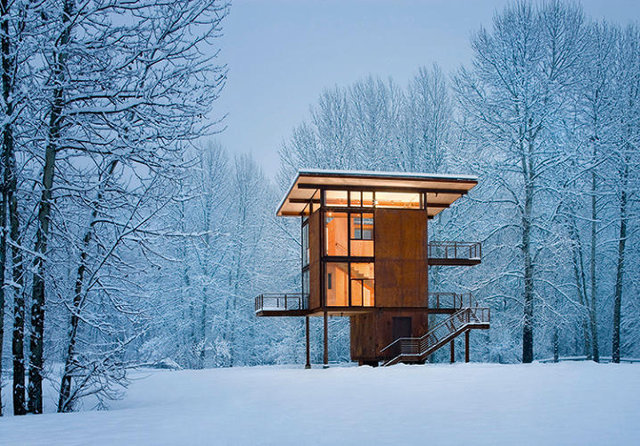As much as we love gorgeous small-scale architecture, not all micro-housing is created equal. Over at City Lab, Kriston Capps argues thattiny houses plopped onto huge lots in the middle of nowhere miss the entire point of micro-housing: to provide more options for affordable housing, especially in crowded, expensive cities.
He takes issue with the 650-square-foot prefabricated zeroHouse, the self-sufficient modular home seen above:
The zeroHouse is so modular and low maintenance, in fact, that all you need to own a zeroHouse is—after $350,000—a plot of land. Any kind of land.
Which is, of course, the problem with zeroHouse: Nobody needs micro-housing in places where plots of prairie, mountain, and sea (!) are available in plenty.

If you’re determined to live on a sprawling piece of rural land, it’s probably more environmentally friendly to do so in a prefab house that’s designed to function off the grid. “Basically, a tiny house is sort of the suburban or maybe even rural version of a small apartment,” asRyan Mitchell, author of the book Tiny House Living, told Salon.
But trendy tiny dwellings more often come in this form than the variety people more desperately need: the kind that makes urban living affordable for those of us who aren’t oligarchs. “Lovely granny flats, Voltron head-cubes, and stories that tug at the heart-strings are nice, but support for these doesn’t amount to support for real micro-housing—or congregate housing developments, perhaps a better term for urbanist housing solutions,” Capps writes.
What cities need in micro-housing, he argues, is “at least the option to build for a range of buyers and renters, at a range of densities. When tiny-house enthusiasts go on about what are essentially single-family homes, they are confirming the status quo, if shrinking it a little.”
Ultimately, we need both. It’s true that crowded cities—especially those with a high concentration of young professionals who aren’t trying to fit an entire family into a 129-square-foot apartment—need affordable micro-units to alleviate intense pressure on the housing market. It’s perhaps no surprise that we don’t see that many of those designs yet, considering that even in housing-strapped cities like San Francisco,micro-apartments remain controversial. The prospect of allowing developers to pack people into a whole new definition of “cozy” worries some tenants rights advocates and even some psychologists.
read more…
http://www.fastcodesign.com/3032535/slicker-city/tiny-houses-have-a-not-so-tiny-problem?fullsite&partner=ps03101titles
